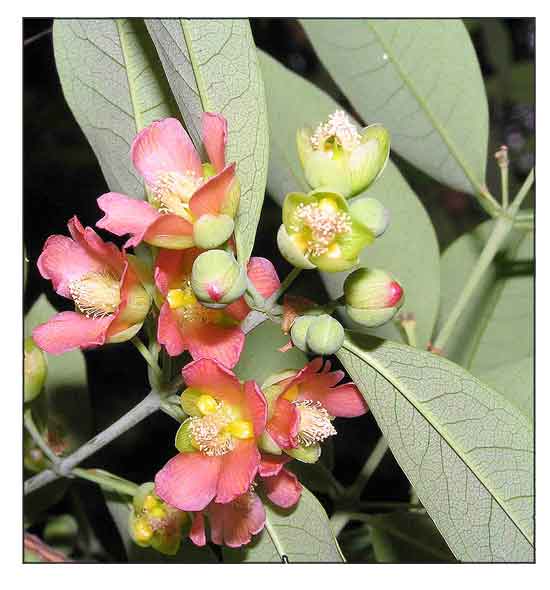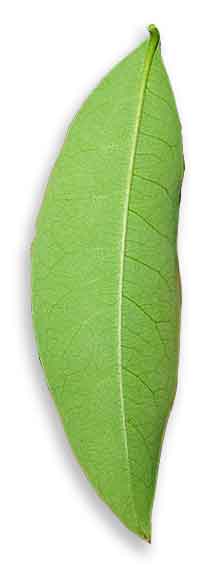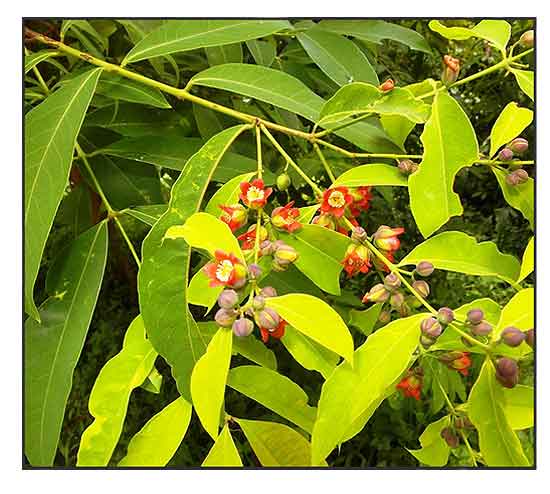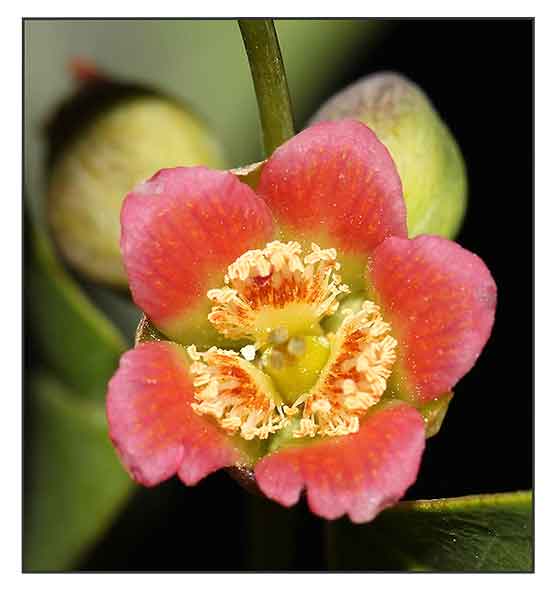 Gen info Gen info
- Cratoxylum (Cratoxylon Blume, an orthographic variant) is a genus of flower plants in the family Hypericaceae.
- Etymology: The genus name derives from Greek meaning "strong wood", referring to its timber quality.
The specific epithet Latinized cochinchinense, means "from Cochinchina", referring to southern Vietnam during its French colonial period.
Botany
• A small to medium-sized, deciduous tree of up to 33 m tall, bole often of poor shape, sometimes fluted at the base, up to 55 cm in diameter, bark surface smooth, peeling off in angular pieces or long strips with age, light brown to yellowish-brown, inner bark light green to greenish-yellow. Leaves elliptical to ovate-lanceolate or lanceolate, 3-10.5 cm × 1-4 cm, with an obtuse to acutely acuminate apex, glaucous beneath. Inflorescence consisting of small 1-5-flowered terminal or axillary cymes; flowers heterodistylous, petals dark red to pink or orange, without a nectary scale. Seeds (5-)6-8 per locule, unilaterally winged. (1)
 • Tree or shrub, to c. 30 m tall, deciduous, glabrous; bark smooth, pale or scaly, grey-brown; young shoots with interpetiolar scar continuous or interrupted. Leaves with petiole 2-5 mm, 3-10½ by 1-4 cm, elliptic to ovate-lanceolate or lanceolate, apex obtuse to acutely acuminate, base broadly cuneate to attenuate, herbaceous to chartaceous, nearly always glaucous beneath. Inflorescence of 1-5-flowered axillary and usually terminal cymules; pedicels 1-2 mm. Flowers heterodistylous. Sepals 5-7 by 2-5 mm. Petals dark red to pink or orange, 5-10 by 2½-5 mm. Stamen fascicles 4-8 mm long, with stamens ± congested, c. 45-55 per fascicle; anther gland sometimes present. Staminodial fascicles (if developed) yellow, up to 3 mm long, flattened, oblong to obovate, cucullate. Ovary 2-3 mm long; styles 1-3 mm. Capsule 8-12 by 4-5 mm, c. 1-1½ times as long as sepals, ellipsoid-cylindric, with columella basal. Seeds (5-)6-8 per loculus, 6-8 by 2-3 mm, oblanceolate to elliptic or oblong. • Tree or shrub, to c. 30 m tall, deciduous, glabrous; bark smooth, pale or scaly, grey-brown; young shoots with interpetiolar scar continuous or interrupted. Leaves with petiole 2-5 mm, 3-10½ by 1-4 cm, elliptic to ovate-lanceolate or lanceolate, apex obtuse to acutely acuminate, base broadly cuneate to attenuate, herbaceous to chartaceous, nearly always glaucous beneath. Inflorescence of 1-5-flowered axillary and usually terminal cymules; pedicels 1-2 mm. Flowers heterodistylous. Sepals 5-7 by 2-5 mm. Petals dark red to pink or orange, 5-10 by 2½-5 mm. Stamen fascicles 4-8 mm long, with stamens ± congested, c. 45-55 per fascicle; anther gland sometimes present. Staminodial fascicles (if developed) yellow, up to 3 mm long, flattened, oblong to obovate, cucullate. Ovary 2-3 mm long; styles 1-3 mm. Capsule 8-12 by 4-5 mm, c. 1-1½ times as long as sepals, ellipsoid-cylindric, with columella basal. Seeds (5-)6-8 per loculus, 6-8 by 2-3 mm, oblanceolate to elliptic or oblong.
(3)
Distribution
- Native to the Philippines.
- Also native to
Andaman Is., Borneo, Cambodia, China South-Central, China Southeast, Laos, Malaya, Myanmar, Nicobar Is., Sumatera, Thailand, Vietnam. (2)
-
In primary and secondary forests, in open woodland and grassland, along water courses and sometimes peat swamps, up to 750 m altitude. (1)
Constituents
- Xanthones are the most abundant biologically active secondary metabolites detected in various parts of C. cochinchinense. Xanthones can be synthesized both biologically and synthetically. (see anticancer, antimalarial, antibacterial studies below) (6)
- Study of stems and leaves isolated four new xanthones, cratocochinones A-D (1-4), together with eight known analogues (5-12). (see study below) (7)
- Study of C. cochinchinense bark isolated eight xanthones pruniflorone N (1), pruniflorone M (2), 6-deoxyisojacareubin (3), xanthone V1 (4), macluraxanthone (5), 1,5-dihydroxy-8- methoxyxanthone (6), 1,7-dihydroxy xanthone (7), 5’- demethoxycadesin G (8), along with anthraquinone vismiaquinone D (9), and four common triterpenoids, α-amyrin (9), α-amyrenone (10), lupeol (11), and lupenone (12). (see study below) (9)
 - Study of C. cochinchinense stems and leaves extracts isolated a pair of new xanthone enantiomers, (+)- and (-)-cracochinxanthone A (1a and 1b), along with 30 known analogues (2-31). (see study below) (10) - Study of C. cochinchinense stems and leaves extracts isolated a pair of new xanthone enantiomers, (+)- and (-)-cracochinxanthone A (1a and 1b), along with 30 known analogues (2-31). (see study below) (10)
- Study of bark isolated two undescribed furanoxanthones, cratocochinones A (1) and B (2), along with eight known xanthones (3-10). (see study below) (13)
- Study of stems isolated three xanthones, cratoxylumxanthones B-D (1-3), along with five known xanthones (4-8). (see study below) (16)
- Study of branches and twigs isolated four new xanthones, cratoxanthone A-D (1-4), together with six known xanthones (5-10, and one known dihydroanthracenone (11). (see study below) (18)
- Study of stems isolated a new xanthone named cratoxylum-xanthone A (1), together with five known compounds: dulcisxanthone B (2), alpha-mangostin (3), beta-mangostin (4), 2-geranyl-1,3,7-trihydroxy-4-(3-methylbut-2-enyl)xanthone (5) and tectochrystin (6). (see study below) (19)
- Acetone extract of C. cochinchinense stem bark yielded a new compound, cochinchinone M (1), together with known compounds 1,3,7-trihydroxy-2,4-diisoprenylaxanthone (2), cochinchinone A (3), pruniflorone Q (4), pruniflorone R (5), garcinone C (6), cratoxylone (7), α-mangostin (8), ß-mangostin   (9), 3-O-methylmangostenone D (10), garcinone B (11), 5,9-dihydroxy-8-methoxy-2,2-dimethyl-7-(3-methylbut-2-enyl)- 2H,6H-pyrano[3,2-b]xanthen-6-one (12), and 11-hydroxy-3-O-methyl-1-isomangostin (13). (see study below) (20)
Properties
- Flowers are faintly aromatic.
- Studies have suggested cytotoxic, anticancer, antibacterial, antimalarial, antioxidant, anti-HIV, anti-inflammatory, neuraminidase inhibitory, antibacterial, acetylcholinesterase inhibitory properties.
Parts used
Leaves, bark, roots
 Uses Uses
Edibility
- Young fruit used as spice for cooking.
- Young leaves used as substitute for tea.
Folkloric
- In Southeast Asian communities, decoction mixture of bark and leaves used to treat fever. Wood tar is used to blacken teeth, and decoction of roots given to women as post-labor tonic. (4)
- Twigs, bark, and roots used to treat colds and diarrhea. (5)
- Used for treatment of fevers, diarrhea, ulcer, itches, cough, edema, and abdominal pain.
- In Vietnam, bark, roots, and leaves used for fevers, cough, scabies, stomach aches, eczema; twigs used for scabies and burns. In Thailand, used for ulcers, diarrhea, itches, and as diuretic. In China, used as detoxification medicine, to treat fever, diarrhea, jaundice, carbuncles, common colds, edema, hoarseness, and cancer. (6)
Others
- Wood: Moderately hard and heavy. Used for medium to heavy construction, for making tool handles, wood pallets, and woodcuts. (5)
Studies
• Anticancer Xanthones: Xanthones present in C. cochinchinense have been shown to have anticancer functions. By MTT assay, pruniflorone N exhibited distinct cytotoxic effect against SkBr3 and MCF7 breast, hepatocellular HepG2, IST-MES1 mesothelioma, BG-1 ovarian, and Ishikawa endometrial cancer cells with IC50s in the range of 3-9 µM while xanthone V1 showed moderate effect on all cells with IC50 in the range of 18-25 µM. Cratoxanthone B and garcinone E demonstrated strong inhibitory effect on cell proliferation in human acute lymphoblastic leukemia B cell line (NALM-6) with IC50s of 8.27 and 8.67 µM, respectively. Garcinone E and alpha-mangostin moderately inhibited the growth of KB epidermoid carcinoma cell line with IC50s of 24.24 and 19.86 µM respectively. (6)
• Antibacterial Xanthones: Alpha-mangostin, one of the xanthones identified from the roots of C. cochinchinense, has been shown to possess antibacterial activities against vancomycin-resistant Enterococci (VRE) and methicillin-resistant Staphylococcus aureus (MRSA) with MICs of 3.13 to 6.25 and 6.26 to 12.5 µg/ml, respectively. Alpha-mangostin exhibited a synergistic effect against vancomycin-resistant Enterococci, while alpha-mangostin and vancomycin Hcl showed synergy against MRSA. Other studies have shown alpha-mangostin used with other antibiotics such as ampicillin and minocycline also exhibited synergism. The studies suggest potential for antibiotics use in combination with xanthones against antibiotic-resistant microbes, especially in nosocomial infections. (6)
• Antimalarial Xanthones: Study of roots of C. cochinchinense isolated a new prenylated xanthone, 5-O-methylcelebixanthone, along with known celebixanthone, cochinchinone C, and beta-mangostin. The compounds strong antimicrobial activity against Plasmodium flaciparum with IC50s of 3.2, 4.9, 2.6, and 7.2 µg/ml, respectively. The methoxyl group bonded at C-3 of beta-mangostin contributed to the high antimalarial activity against P. falciparum. (6)
• Antioxidant / Radical Scavenging Xanthones: Xanthones have been found to exert antioxidant effects, which are crucial to prevent health disorders caused by free radicals in the body. Celebixanthone, alpha-mangostin, cudratricusxanthome E. norathyriol, isocudraniaxanthone, macluraxanthone, and mangiferin have all been reported to have antioxidant properties. At concentration of 50 µM, celebixanthone and macluraxanthone exhibited strong DPPH radical scavenging activity with IC50s of 12.3 and 19.0 µM, respectively. (6)
• Anti-Inflammatory / Anti-HIV / Xanthones / Stems and Leaves: Study of stems and leaves isolated four new xanthones, cratocochinones A-D (1-4), together with eight known analogues (5-12). Compounds 1-12 showed remarkable inhibitory activities on nitric oxide (NO) production induced by lipopolysaccharide in mouse macrophage RAW 264.7 cells in vitro, with IC50s in range of 0.86 to 18.36 µM. Compounds 1-12 also exhibited significant anti-HIV activities with EC50s range from 0.22 to 11.23 µM. An 85% ethanol extract of stems and leaves showed anti-HIV1 reverse transcriptase (RT) effect with EC50 of 7.19 µg/ml. (7)
• Effect on Global mRNA Gene Expression in HepG2 Liver Cancer Cells / Bark: Study evaluated the effects of various extracts of C. cochinchinense on global gene expression in HepG2 liver cells. A bark petroleum ether (PE) extract exhibited the most cytotoxic effect towards the cells, which was chosen for microarray gene expression analysis. The bark extract showed significant potential in regulating the multiple dysfunctional signaling pathways in HCC. Results suggest CC has inhibitory effect on HepG2 cancer cells. (8)
• Highly Cytotoxic Xanthones Against Cancer Cell Lines / Bark: Study of C. cochinchinense bark isolated eight xanthones and one anthraquinone, together with fur common triterpenoids. MTT assay evaluated the antiproliferative activities against six human tumor cells lines. Pruniflorone N (1) showed significant cytotoxicity against all cancer cell lines with IC50s in range of 3-9 µM, on average higher than anticancer drug cisplatin. (see constituents above) (9)
• Enantiomers of Xanthones / Anticancer / Stems and Leaves: Study of C. cochinchinense stems and leaves extracts isolated a pair of new xanthone enantiomers, (+)- and (-)-cracochinxanthone A (1a and 1b), along with 30 known analogues (2-31). Some of the xanthones exhibited high activity against three human malignant cell lines. Structure-activity relationship showed that the prenyl and geranyl units may play a role in the antitumor activity. (10)
• Bacterial Neuraminidase Inhibition: Study of C. cochichinense roots isolated a series of xanthones (1-6). The analogues within the series were highly inhibitory with excellent affinity against bacterial neuraminidase (BNA). BNA has been associated with various biological functions such as pathogenic bacterial infection, inflammatory process after infection, and biofilm formation. Results suggest the potential of xanthones from C. cochinchinense for development of novel BNA inhibitors. (11)
• YCT / Cell Death Induced by Antioxidant Extract: YCT is a semipurified extract from Cratoxylum cochinchinense that has antioxidant properties and contains mostly mangiferin. Study showed YCT is selectively toxic to certain type cells, such as Jurkat T cells. YCT causes intense oxidative stress and a rise in cytosolic Ca2+, followed by rise in mitochondrial Ca2+, release of cytochrome c. collapse of  Δψm, a fall in ATP levels, and eventual cell death. The mechanism of intense oxidative stress may involve a plasma membrane redox system. While antioxidants are invariably assumed as beneficial, study showed the antioxidant extract YCT induces cell death in certain cell types. (12)
• α-Glucosidase Inhibitory Activity / Antidiabetic / Xanthones / Bark: Study of bark isolated two undescribed furanoxanthones, cratocochinones A (1) and B (2), along with eight known xanthones (3-10). Seven compounds, 3-6 and 8-10 exhibited strong inhibitory effect than positive control, acarbose. Cochinxanthone A (6) showed remarkable inhibition with IC50 of 59.6 µM, approximately 16-fold more potent than acarbose. (13)
• Cytotoxic Xanthones Against Cancer Cell Lines / Roots: Study of roots isolated two new xanthones, namely cratochinone A (1) and cratochinone B (2), along with 16 known xanthones. All compounds were evaluated for cytotoxicity against five human cancer cell lines (KB, HeLa S-3, HT-29, MCF-7, and HepG2 cell lines). Compounds 1, 5, and 7 showed signficant cytotoxic effects against all cell lines with IC50s range of 0.91 - 9.93 µM. Compound 10 exhibited cytotoxicity against KB, HeLa S-3 and HT-29 with IC50s of 7.39, 6.07, and 8.11 µM, respectively. Compound 12 showed cytotoxicity against both KB and HeLa S-3 cells with IC50s of 7.28 and 9.84 µM. (14)
• Cytotoxic / NF-kB inhibitory / Stems: Study of stems isolated a new caged xanthone (1), a new prenylxanthone (2), seven known xanthones, and a known sterol glucoside. Several were found cytotoxic toward HT-29 human colon cancer cells, the most potent of which being 3,6-di-O-acetyl-α-mangostin (8) with ED50 of 1.0 µM. In NF-kB p65 inhibition assay, 1,3,7-trihydroxy-2,4-diisopreyl-xanthone (5) exhibited most potent activity (IC50 2.9 µM). (15)
• Antioxidant / Xanthones / Stems: Study of stems isolated three xanthones, cratoxylumxanthones B-D (1-3), along with five known xanthones (4-8). Cochinxanthone D (4) exhibited the most potent antioxidant activity in both DPPH radical scavenging and lipid peroxidation inhibition assays. (16)
• Canophyllol / Antidiabetic / Leaves: Study evaluated the potential anti-diabetic activity of canophyllol (CNPL) and its invivo and invitro mechanisms. Results showed the CNPL may improve glucose tolerance, reduce hyperglycemia, normalize insulin secretion, and ameliorate lipid metabolism disorders. The diverse antidiabetic effects of CNPL may be attributed to regulation of GLUT4, PPARγ.AMPK phosphorylation and ACC phosphorylation. (17)
• Xanthones / Antiproliferative Effects / Branches and Twigs: Study of branches and twigs isolated four new xanthones, cratoxanthone A-D (1-4), together with six known xanthones (5-10, and one known dihydroanthracenone (11). The new xanthones 1 and 2 attenuated NALM-6 cell proliferation with IC50s of 17.78 and 8.27 µM, respectively. KB cells treated with these compounds showed significantly decreased mitochondrial membrane potentials. Notably, proliferation of A549 cells was inhibited by 11, not by xanthones. (18)
• Antioxidant Xanthones / Stems: Study of stems isolated a new xanthone named cratoxylum-xanthone A (1), together with five known compounds: dulcisxanthone B (2), alpha-mangostin (3), beta-mangostin (4), 2-geranyl-1,3,7-trihydroxy-4-(3-methylbut-2-enyl)xanthone (5) and tectochrystin (6). The isolated compounds showed free radical scavenging against DPPH and lipid peroxidation inhibition. (19)
• Bioactive Xanthones / Antibacterial / Anticholinesterase Inhibitory / Stem Bark: Study of stem bark yielded a new compound, cochinchinone M (1), together with 12 other known compounds. Compounds 6 (garcinone) and 8 (α-mangostin) exhibited AChE inhibition with IC50s of 1.80 and 15.53 µM. Compounds 1-7, 9 and 12 showed good antibacterial activity against M. luteus with MIC < 8 µg/mL, with compound 1 showing strongest activity with MIC of 1 µg/nL. (see constituents above) (20)
• Cytotoxic / Antimalarial Prenylated Xanthones / Roots: Study of roots isolated a new prenylated xanthone, 5-O-methylcelebixanthone (1), together with six known compounds, namely: celebixanthone (2), 1,3,7-trihydroxy-2,4-di(3-methylbut-2-enyl)xanthone (3), cochinchinone A (4), alpha-mangostin (5), beta-mangostin (6) and cochinchinone C (7). Compounds 2 and 4-7 showed cytotoxic activity against human lung cancer cell line (NCI-H187) with IC50s ranging from 0.65-5.2 µg/,L. Compounds 1, 2, 6 and 7 also showed antimalarial activity against Plasmodium falciparum with IC50s of 3.2, 4.9, 7.2 and 2.6 µg/ml, respectively. (21)
• Antimicrobial Against Porphyromonas gingivalis: Porphyromonas gingivalis is one of the keystone pathogens of periodontitis. Study characterized P. gingivalis ATCC 33277 and evaluated the antimicrobial activities of methanolic extract of C. cochinchinense and flucytosine against the bacteria using microbroth dilution method. Minimum inhibitory concentration (MIC) of ME of C. cochinchinense and flucytosine were 0.25 mg/ml and 200 µM respectively. (22)
Availability
Wild-crafted.
Seeds in the cybermarket.
|

![]()




 • Tree or shrub, to c. 30 m tall, deciduous, glabrous; bark smooth, pale or scaly, grey-brown; young shoots with interpetiolar scar continuous or interrupted. Leaves with petiole 2-5 mm, 3-10½ by 1-4 cm, elliptic to ovate-lanceolate or lanceolate, apex obtuse to acutely acuminate, base broadly cuneate to attenuate, herbaceous to chartaceous, nearly always glaucous beneath. Inflorescence of 1-5-flowered axillary and usually terminal cymules; pedicels 1-2 mm. Flowers heterodistylous. Sepals 5-7 by 2-5 mm. Petals dark red to pink or orange, 5-10 by 2½-5 mm. Stamen fascicles 4-8 mm long, with stamens ± congested, c. 45-55 per fascicle; anther gland sometimes present. Staminodial fascicles (if developed) yellow, up to 3 mm long, flattened, oblong to obovate, cucullate. Ovary 2-3 mm long; styles 1-3 mm. Capsule 8-12 by 4-5 mm, c. 1-1½ times as long as sepals, ellipsoid-cylindric, with columella basal. Seeds (5-)6-8 per loculus, 6-8 by 2-3 mm, oblanceolate to elliptic or oblong.
• Tree or shrub, to c. 30 m tall, deciduous, glabrous; bark smooth, pale or scaly, grey-brown; young shoots with interpetiolar scar continuous or interrupted. Leaves with petiole 2-5 mm, 3-10½ by 1-4 cm, elliptic to ovate-lanceolate or lanceolate, apex obtuse to acutely acuminate, base broadly cuneate to attenuate, herbaceous to chartaceous, nearly always glaucous beneath. Inflorescence of 1-5-flowered axillary and usually terminal cymules; pedicels 1-2 mm. Flowers heterodistylous. Sepals 5-7 by 2-5 mm. Petals dark red to pink or orange, 5-10 by 2½-5 mm. Stamen fascicles 4-8 mm long, with stamens ± congested, c. 45-55 per fascicle; anther gland sometimes present. Staminodial fascicles (if developed) yellow, up to 3 mm long, flattened, oblong to obovate, cucullate. Ovary 2-3 mm long; styles 1-3 mm. Capsule 8-12 by 4-5 mm, c. 1-1½ times as long as sepals, ellipsoid-cylindric, with columella basal. Seeds (5-)6-8 per loculus, 6-8 by 2-3 mm, oblanceolate to elliptic or oblong.

